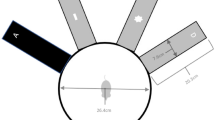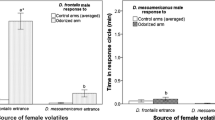Abstract
Olfactory cues from conspecifics have strong influences on behavior. Both female and male juveniles are attracted to familiar odors while adults show preferences for odors of opposite-sex conspecifics. Females show an increased preference for male odors as they mature, but no study has examined whether change with age is seen in males. In this experiment, responses of weanling and mature male and female pine voles (Microtus pinetorum) to familiar odor cues from their family versus those of an unfamiliar, opposite-sex conspecific were examined. Voles were tested in a three-chambered cage with end chambers containing the stimuli. There was a significant difference in odor preference between weanling and mature females. Weanling females preferred odor cues from their families, and mature females preferred the odors of unfamiliar mature males. The pattern was similar in males but the effect was not as strong. The results support the hypothesis that responses to odor cues change with age in pine voles. At least for females, the change in response to odor cues may be involved in the timing of reproduction and thus dispersal.
Similar content being viewed by others
REFERENCES
BENNETT, N. C. 1994. Reproductive suppression in social Cryptomys damarensis colonies—a lifetime of socially-induced sterility in males and females (Rodentia: Bathyergidae). J. Zool. London 234:25–39
BRONSON, F. H. 1976. Urine marking in mice: Causes and effects, pp. 119–141, in R. L. Doty (ed.). Mammalian Olfaction, Reproductive Processes and Behavior. Academic Press, New York
BROWN, R. E. 1979. Mammalian social odors: A critical review. Adv. Study Behav. 10:103–162
BROWN, R. E., and MACDONALD, D. W. (eds.). 1985. Social Odors in Mammals, Vols. 1 and 2. Clarendon Press, Oxford
COPPOLA, D. M., and O'CONNELL, R. J. 1988. Behavioral responses of peripubertal female mice towards puberty-accelerating and puberty-delaying chemical signals. Chem. Senses 13:407–424
CREEL, S. R., and WASER, P. M. 1990. Failures of reproductive suppression in dwarf mongooses (Helogale parvula): Accident or adaptation? Behav. Ecol. 2:7–15
CREEL, S. R., and WASER, P. M. 1997. Variation in reproductive suppression among dwarf mongooses: Interplay between mechanisms and evolution. in N. G. Solomon and J. A. French (eds.). Cooperative Breeding in Mammals. Cambridge University Press, Cambridge
DRICKAMER, L. C. 1989a. Odor preferences of wild stock female house mice (Mus domesticus) tested at three ages using urine and other cues from conspecific males and females. J. Chem. Ecol. 15:1971–1987
DRICKAMER, L. C. 1989b. Patterns of deposition of urine containing chemosignals that affect puberty and reproduction by wild stock male and female house mice (Mus domesticus). J. Chem. Ecol. 15:1407–1421
DRICKAMER, L. C. 1992a. Oestrous female house mice discriminate dominant from subordinate males and sons of dominant from sons of subordinate males by odour cues. Anim. Behav. 43:868–870
DRICKAMER, L. C. 1992b. Behavioral selection of odor cues by young female mice affects age of puberty. Dev. Psychobiol. 25:461–470
FERKIN, M. H. 1989. Adult-weanling recognition among captive meadow voles (Microtus pennsylvanicus). Behaviour 108:114–124
FERKIN, M. H., and RUTKA, T. F. 1990. Mechanisms of sibling recognition in meadow voles. Can. J. Zool. 68:609–613
FERKIN, M. H., and JOHNSTON, R. E. 1995. Meadow voles, Microtus pennsylvanicus, use multiple sources of scent for sex recognition. Anim. Behav. 49:37–44
FERKIN, M. H., FERKIN, F. H., and RICHMOND, M. 1994. Sources of scent used by prairie voles. Microtus ochrogaster, to convey sexual identity to conspecifics. Can.J. Zool. 72:2205–2209
HALPIN, Z. T. 1986. Individual odors among mammals: Origins and functions. Adv. Study Behav. 16:39–70
HOLEKAMP, K. E. 1986. Proximal causes of natal dispersal in Belding's ground squirrels (Spermophilus beldingi). Ecol. Monogr. 56:365–391
HOWELL, D. C. 1982. Statistical Methods in Psychology. Duxbury Press, Boston
HURST, J. L. 1987. The functions of urine marking in a free-living population of house mice, Mus domesticus. Anim. Behav. 35:1433–1442
HURST, J. L. 1989. The complex network of olfactory communication in populations of wild house mice Mus musculus Rutty: Urine marking and investigation within family groups. Anim. Behav. 37:705–725
HURST, J. L. 1990. Urine marking in populations of wild house mice Mus domesticus Rutty III. Communication between the sexes. Anim. Behav. 40:233–243
HURST, J. L., and NEVISON, C. M. 1994. Do female house mice, Mus domesticus, regulate their exposure to reproductive priming pheromones? Anim. Behav. 48:945–959
JOHNSTON, R. E. 1980. Responses of male hamsters to odors of females in different reproductive states. J. Comp. Physiol. Psychol. 5:894–904
KERR, L. 1994. Family influences on sexual maturation in male pine voles. Undergraduate honors thesis. Miami University, Oxford, Ohio
LEPRI, J. J., and VANDENBERGH, J. G. 1986. Puberty in pine voles, Microtus pinetorum, and the influence of chemosignals on female reproduction. Biol. Reprod 34:370–377
MYKYTOWYCZ, R. 1974. Odor in the spacing behavior of mammals, pp. 327–343, in M. C. Birch (ed.), Pheromones. North-Holland Publishing, Amsterdam
RICHMOND, M., and CONWAY, C. H. 1969. Induced ovulation and oestrus in Microtus ochrogaster J. Reprod. Fertil. 6(Suppl.):357–376
RICHMOND, M., and STEHN, R. 1976. Olfaction and reproductive behaviour in microtine rodents, pp. 197–219, in R. L. Doty (ed.). Mammalian Olfaction, Reproductive Processes, and Behavior. Academic Press, New York
SCHADLER, M. H., and BUTTERSTEIN, G. M. 1979. Reproduction in the pine vole, Microtus pinetorum. J. Mammal. 60:841–844
SOLOMON, N. G. 1993. Body size and social preferences of male and female prairie voles (Microtus ochrogaster). Anim. Behav. 45:1031–1033
SOLOMON, N. G., and VANDENBERGH, J. G. 1994. Management, breeding, and reproductive performance of pine voles. Lab. Anim. Sci. 44:613–617
SOLOMON, N. G., VANDENBERGH, J. G., WEKESA, K. S., and BARGHUSEN, L. 1996. Chemical cues are necessary but insufficient for reproductive activation of female pine voles (Microtus pinetorum). Biol. Reprod. 54:1038–1045
TARDIF, S. D. 1984. Social influences on sexual maturation of female Saguinus oedipus oedipus. Am. J. Primatol. 6:199–209
ZIEGLER, T. E., SAVAGE, A., SCHEFFLER, G., and SNOWDON, C. T. 1987. The endocrinology of puberty and reproductive functioning in female cotton-top tamarins (Saguinus oedipus) under varying social conditions. Biol. Reprod. 37:618–627
Author information
Authors and Affiliations
Rights and permissions
About this article
Cite this article
Solomon, N.G., Rumbaugh, T. Odor Preferences of Weanling and Mature Male and Female Pine Voles. J Chem Ecol 23, 2133–2143 (1997). https://doi.org/10.1023/B:JOEC.0000006434.97821.fa
Issue Date:
DOI: https://doi.org/10.1023/B:JOEC.0000006434.97821.fa




